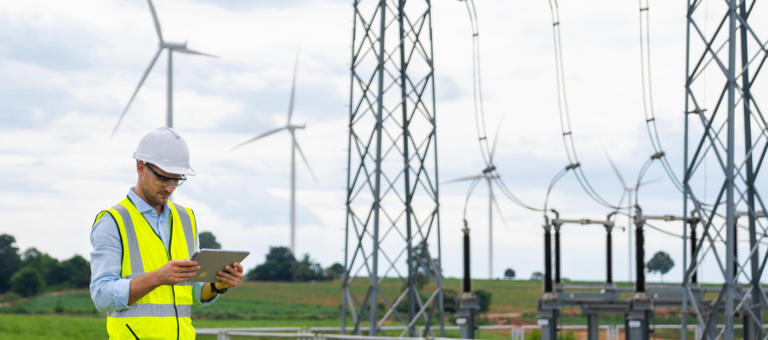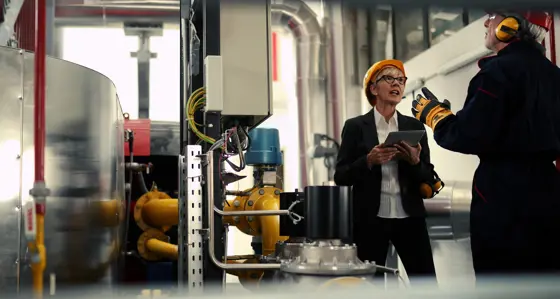
Accelerating the energy transition with digital innovation
7 min read 24 January 2024
Leaders in the energy transition are in a race against time. The goal? Build a new low-carbon infrastructure faster while decarbonising existing energy systems at the same time.
It’s a shift that adds huge complexity. Not only are there more energy types, but the distributed and intermittent nature of the new generation mix, disruptive market players, and changing customer expectations all create challenges.
Digital innovation is the key to optimising within this complex energy landscape, supporting decarbonisation and building long-term customer trust. This means we’re entering an age where energy leaders will be digital leaders.
In this article, we’ll explore how digital technologies can help energy leaders build a low-carbon energy system and:
- Deliver and operate new energy infrastructure
- Use data in a dynamic energy system
- Engage and empower energy consumers and prosumers.

Digital’s role in delivering and operating the new energy infrastructure
The smart application of digital solutions can transform the performance, profitability, and success of renewable energy infrastructure projects.
Digital solutions for accelerating delivery
The global energy transition is a major undertaking. It’s estimated, for example, that 80 million km of transmission infrastructure will need to be added or replaced by 2040.
In a complex system, moving quickly can increase risk. So, how can digital solutions enable and accelerate the delivery of major capital investments in energy infrastructure while minimising risk?
Today, many energy businesses rely on traditional project planning tools. But these often create siloed approaches, and they’re becoming obsolete. At Baringa, we advocate digital tools that provide joined-up insight across a whole programme of work and, ideally, the full value chain of an asset as it goes online. Digital tools for infrastructure include:
- Concept optimisation solutions, using data-driven modelling that optimises the asset configuration of a project.
- Augmented planning and project management solutions, using scenario planning and optimisation tools to improve integrated programme plans and resource allocation.
- Digital engineering and construction management tools to streamline, and enable design visualisation, risk management and stakeholder collaboration.
- Bridging digital to physical from build through to operation, using data contextualisation and visualisation systems, like digital twins.
The energy transition challenges developers to work at, or even beyond, the cutting edge of their proven capabilities. The use of digital-twin solutions helps to de-risk innovation.
Digital twins – digital solutions for physical problems
Digital twins build a complete data picture of an entire network or set of assets from the outset of a project and augment it with insight as the infrastructure operates. To be successful, they require a constant flow of data, fed by purpose-built sensors on physical assets, to enable better commercial and operational management as well as predictive maintenance.
The shift to renewable energy and adjustments to our energy system require significant investment and resources. One of the top priorities is addressing stresses in the supply chain, particularly shortages of materials and equipment. Because digital twins of energy assets can incorporate engineering, modelling, and climate insights, they’re able to support robust decision-making even where time and resources are limited.
Baringa clients are successfully using digital twins to support their supply chains along with physical operations across the whole energy spectrum from transmission and distribution, through to upstream assets spanning gas, liquified natural gas (LNG) and green hydrogen. We work with these organisations to help them navigate the commercial and operational parameters for their digital twin projects.
Digitising the supply chain – universal approaches, new skills
Supplying the equipment, materials and human resources needed in the digital energy transition means connecting the end-to-end physical and services supply chain. Key to delivering on capital project and operations expectations, this requires data sharing between multiple parties to create a digital supply chain that bridges traditional company boundaries.
We are working with clients that are using emerging digital systems to build visibility and manage exposure across their supply chains, as well to gather data and insight for ESG and other quality and standards reporting. Digital tools also play a key role in negotiation and transactions.
The value of data in an increasingly dynamic energy system
We need to combat the intermittency of supply and lack of inertia linked to an increasingly renewable and distributed energy system. This means reinventing the way we manage the system from end to end.
Lifting the burden of intermittency with digital platforms
Electrification is burdening transmission and distribution networks that weren’t built to handle intermittency. This challenge is intensifying as decarbonisation drives increased adoption of electrified appliances, spanning everything from vehicles to heat pumps.
Increased energy storage is needed to cope with intermittency. Digital will play a key part in optimising this storage, as well as supporting the digitally enabled demand-side flexibility that enables an electricity grid to manage peaks in energy demand.
Using data to optimise existing systems and build value
Without an energy data superhighway, there simply won’t be sufficient power to go around. It’s why virtual power plants (VPPs) are becoming increasingly common and will play an important role in making the use of power much more efficient.
These digital platforms aggregate distributed power generation and provide insights that help align consumption peaks with periods of excess supply, returning power to the grid when demand is high (coordinating the timing of electric vehicle charging, for example).
Data brings all this together
Consolidated data can create value by providing organisations with an end-to-end view of operations from the outset.
The commercial whole is always greater than the disjointed sum of its parts. For instance, in the hydrogen space, digital platforms can perform the analysis required to optimise across both the short trading windows of the power markets as well as supporting physical infrastructure decisions (such as electrolyser, pipeline, and refinery ramp-up/ramp-down rates).
Real-time prices create agency and flexibility
In some markets, the move from day-to-day to same-day and, eventually, to real-time data is already underway. In Great Britain, with the advent of market-wide half-hourly settlement for residential properties, some customers are already being rewarded for responding to price signals in the moment. This is set to increase, with consumers nudged by prompts such as ‘swipe left to turn off your energy for an hour’.
The ESO DFS trial is one example. This rewarded people for reducing their overall consumption, with those who gained most switching off their entire house during the peak period. This represents a fundamental change in how the energy business operates. It requires investment, coordination, and standardisation.
Change and volatility create opportunities
With the energy transition bringing volatility to the wider energy and commodities market, we’re seeing businesses seeking to become more scalable and flexible so they can rapidly take advantage of new commercial opportunities.
For many trading clients, existing Energy Trading & Risk Management (ETRM)-centric trading technology architectures are increasingly seen as unable to support the requirements of low-carbon technologies and intra-day market price volatility.
We are working with trading businesses to shape new data-centric architectures. These enable trading businesses to model and onboard new trading activities quickly, translate higher traded volumes into portfolio-wide risk positions in a timely manner, and benefit from advanced analytics and GenAI at scale.
Power to the people: engaging and empowering digitised consumers and prosumers

The shift to renewable energy fundamentally reshapes customer relationships. It creates opportunities for consumers and businesses to produce energy, as well as store power through microgeneration and batteries. This enables these ‘prosumers’ to sell the energy they’ve generated when prices are high and buy or store power when prices are low.
Energy companies can use digital tools to collect data on prosumers’ energy generation and consumption. Combining real-time grid information, weather forecasts and predictive algorithms enables demand-side management. We are working with energy companies and large energy users that are taking the opportunity to optimise the use of their assets, create flexibility in the grid, provide end-customers with heat and energy and smooth the demand curve.
Along with large energy-user prosumers, residential prosumers are gaining greater control and autonomy in their energy usage from the new digital energy systems.
Green shoots for engaging energy consumers
Cloud-based software-as-a-service (SaaS) platforms help retailers to support consumers digitally, in real time. These platforms also drive innovation by enabling greater access to data, API-based integration with digital solutions and a faster, cheaper route-to-market for new products.
This enables energy suppliers to focus on using data to develop offerings for customers, instead of simply managing customers' accounts through contact centres. SaaS platforms can also lower costs and increase service quality, leading to a higher net-promoter score.
Energy suppliers are increasingly forecasting customer demand and price sensitivity on a half-hourly basis and providing customers with informed choices around their energy usage in a much more precise way using digital technologies. This also helps the distribution network (Distribution System Operator DSO) to optimise use of the network by enabling them to procure and use flexibility services at the local grid level.
All this is driving the need for a ‘digital spine’ – where technology and data converge with business strategy, people and operations to drive digital transformation, create new business models, processes and products and open out a wealth of job and career opportunities.
New skills and faces in the mix
As the sector shifts to delivering renewable power at scale, companies are building new centres of engineering and commercial expertise in all these areas. At the same time, the expanded role of digital technology means that energy companies, and their supply chain and technology partners are all seeking employees with digital skills. The talent in digital innovation is diverse and dynamic and requires constant refreshing.
Digital skills include both deep technical ability in data and AI tools and their role within the energy value chain; as well as business insight of the contribution of data and AI, to direct and use these tools for commercial, stakeholder, and customer value.
We’ve been helping companies to develop the skills they need in the new low-carbon energy system, as well as working with digital leaders as they develop and re-skill their teams to address today’s digital imperatives and emerging stakeholder dynamics.
Closing thoughts
The digitally-led energy sector empowers everyone in the energy value chain to make informed decisions, coordinate supply with demand and engage with consumers and prosumers.
Today, digital tools are helping leading organisations to:
- Accelerate infrastructure delivery
- Operate new and better energy types
- Accelerate responses to market price signals
- Develop new commercial opportunities
- Empower consumers and prosumers
- Improve service quality and
- Lower costs in customer service and operations functions.
So how can all energy value chain participants achieve the same results and succeed in this new energy world?
Here at Baringa, we believe the answer lies in focusing on transformative digital value cases, building expertise in key technologies, and developing leadership in data and AI. to do all this, organisations must invest in the right digital and data technologies as part of a clear vision and strategy.
At Baringa, we are energy experts operating at the heart of digital transformation. We help our clients to achieve real commercial value from their digital investments, while putting citizens, customers, and employees at the centre of our approach.
This means we can help you to deploy the right technology solutions, at the right time and, most importantly, to help bring everyone you need along for the journey.
Let us help you find your best digital route through the energy transition.
Our Experts





Our Impact

Transforming Spirit Energy's digital operations
How do we leverage the latest technology to improve performance?
Read more
Turning RWE Supply & Trading into data leaders
How do you help an energy trading firm turn a mountain of data into a competitive advantage?
Read more
Leading the charge to a digital future
How did a German utilities company transform trading to remain competitive and get ahead in the energy transition?
Read more
Overhauling customer service for British Gas and saving £30 million
What if you could give your customers better experiences and cut operating costs?
Read moreIs digital and AI delivering what your business needs?
Digital and AI can solve your toughest challenges and elevate your business performance. But success isn’t always straightforward. Where can you unlock opportunity? And what does it take to set the foundation for lasting success?